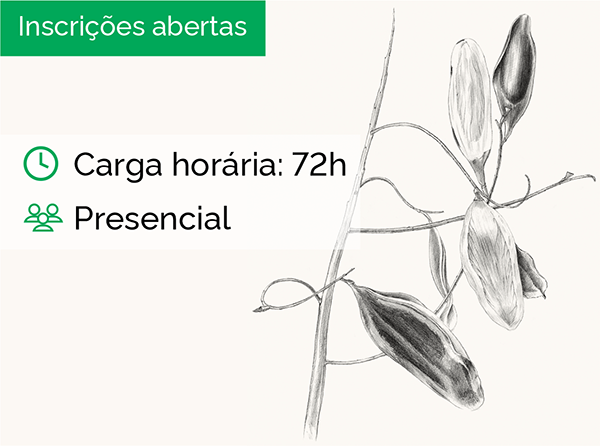Notícias
Botanical illustration - graphite and ink

Teachers: Malena Barretto and Paulo Ormindo
Workload: 72 hours
Registration period: from March 4 to 28, 2024
Period: from April 2 to June 27, 2024 (24 classes).
Day of the week: Tuesday and Thursday
Schedule: Morning from 9 a.m. to 12 p.m. / Afternoon from 2 p.m. to 5 p.m.
Send the completed Registration Form, together with proof of registration, to the following e-mail address: extensao@jbrj.gov.br
Registration: fill in the registration form and send it with proof of payment to extensao@jbrj.gov.br.
Format: Face-to-face
Number of students: 20 students per class
Techniques: Graphite and Nankeen
Target audience: Students and professionals in the areas of Fine Arts, Design, Architecture, Landscaping, Biology, Forestry Engineering and related areas. Students wishing to have contact with Botanical Illustration using the graphite and ink technique. There are no prerequisites.
Investment:
Price: R$1,320.00 - 3x of R$440.00.
The first installment must be paid at the time of registration.
Payment account:
Banco do Brasil
Branch: 2234-9
Current account: 32.075-7
Company name: Fundação de Apoio ao Desenvolvimento da Computação Científica
CNPJ: 06.220.430/0001-03
NOTE: In the event of withdrawal, 10% of the amount invested will be deducted.
Objectives:
To train and qualify designers to support botanical research. The course meets the demand from scientific institutions for designers specialized in botanical illustration. The topics and techniques used in the course provide students with the necessary means to develop their skills as botanical illustrators. At the end of the course, candidates are selected for three voluntary internship positions with a researcher at the Rio de Janeiro Botanical Garden Research Institute.
Syllabus:
Observation drawing of living and herbarium plants using graphite and India ink. Figurative representation of morphological structures with the aid of a hand-held magnifying glass.
Program:
Drawings of leaf types, nervation, leaf arrangement on the stem, dried and fleshy fruits, floral whorls, composition for assembling a botanical board with morphological structures, scales and scientific nomenclature. Observation drawing with instruction on the elements that characterize the species used. Use of pencil to define shapes, light and shade and finish in ink.
Teachers' brief curricula vitae
Malena Barretto is an artist who began her career as a scientific illustrator at the UFRJ National Museum in 1976 and later joined the Rio de Janeiro Botanical Garden Research Institute (JBRJ), where she remained until 1988. In 1989 she received the first Margaret Mee Botanical Foundation Artistic Scholarship to specialize in botanical illustration at the Royal Botanic Gardens of Kew, England. She has participated in group exhibitions, the most recent being "Mata Atlântica Ciência e Arte" at the Museu do Meio Ambiente, Botanical Garden (2015), "Arte Botanica nel Terzo Millenio" at the Museo della Grafica, Pallazo Lafranchi, Pisa (2013). At the Shirley Sherwood gallery at the Royal Botanic Gardens of kew, England, he took part in the exhibitions "Old and New South American Botanical Art" (2010) and "Kew Artists exhibition" (2011). During the France-Brazil year in 2005, she held a solo exhibition of her work at the Parc Floral gallery in Vincennes, Paris. In 1999 she presented watercolors of rare bromeliads in partnership with paintings of bromeliads by Margaret Mee in the exhibition "Masters of Boavista" at the Centro Cultural dos Correios, Rio de Janeiro. Her work can be seen in publications such as "Árvores notáveis, 200 anos do Jardim Botânico do Rio de Janeiro" (2008), "Malena Barretto, aquarelas e desenhos da Flora Brasileira" (2005), "Passion for Plants" (2001), "Segredos e Virtudes das Plantas Medicinais" (1999), "Jardim de Aclimação" (1993) and "Plantas das Caatingas" (1989). She has been a guest lecturer at the JBRJ since 2001.
Paulo Ormindo has a degree in Printmaking from the Federal University of Rio de Janeiro (1992), specializing in Botanical Illustration from the Margaret Mee Botanical Foundation at the Royal Botanic Gardens, Kew - England (1995/1996), and a Master's degree in Art Science from the Fluminense Federal University (2002). Professor at the Federal Rural University of Rio de Janeiro, Fine Arts course (degree) at the Institute of Human and Social Sciences. He has experience in the areas of Art and Botany, with an emphasis on Scientific Drawing, working mainly on the following subjects: botany, illustration, art, watercolor, ink and the History of Botanical Art in Brazil. He has been a visiting professor at the JBRJ since 2001.
List of materials:
- No. HB, 2B and 4B pencils or 2 mm pencils with HB, 2B and 4B graphite
- White TK plastic eraser
- 1 Block of "Canson" Lay-out paper, plain white A3 size 120g/m2 or more 1 Block of A3 tracing paper
- Compass
- Ruler
- Stylus
- A hand-held magnifying glass
- 1 Trident/Desigraph 0.1 fountain pen
- 1 bottle of India ink for pens
Supporting bibliography:
BRITO, A.L.V. Toscano de, Orquídeas da Chapada Diamantina /A.L.V. Toscano de Brito e Phillip J. Cribb; ilustrações de Paulo Ormindo; fotografias de Calil Neto. – Rio de Janeiro: Nova Fronteira, 2005.
CARNEIRO, Diana , Ilustração Botânica: princípios e métodos . Editora UFPR; 2011.
CHRISTABEL,King, The Kew Book of Botanical Illustration, Search Press Limited , 2015.
MEE, Margaret. In search of Flowers of the Amazon Forests. Nonesuch Expeditions Ltd., 1998.
ORMINDO, Paulo (org.) & BARRETTO, M. H. Árvores notáveis 200 anos do Jardim Botânico do Rio de janeiro. Rio de Janeiro: Andrea Jakobsson estúdio, 2008.
STEARN, William T. and Blunt, Wilfrid. The Art of Botanical Illustration. New edition, revised and enlarged Antique Collectors’Club in association with The Royal Botanic Gardens, Kew, 1995.
WEST, Keith. How to Draw Plants. The techniques of botanical illustration, The Herbert Press, 1983.